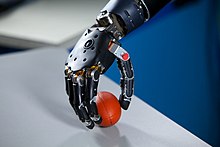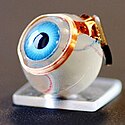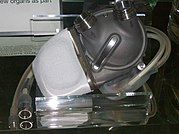Artificial organ
This article needs to be updated. (September 2016) |
An artificial organ is a human made organ device or
Implied by definition, is that the device must not be continuously tethered to a stationary power supply or other stationary resources such as filters or chemical processing units. (Periodic rapid recharging of batteries, refilling of chemicals, and/or cleaning/replacing of filters would exclude a device from being called an artificial organ.)[4] Thus, a dialysis machine, while a very successful and critically important life support device that almost completely replaces the duties of a kidney, is not an artificial organ.
Purpose
Constructing and installing artificial organs, an extremely research-intensive and expensive process initially, may entail many years of ongoing maintenance services not needed by a natural organ:[1][4][5][6]
- providing life support to prevent imminent death while awaiting a transplant (e.g. artificial heart);
- dramatically improving the patient's ability for self care (e.g. artificial limb);
- improving the patient's ability to interact socially (e.g. cochlear implant); or
- improving a patient's quality of life through cosmetic restoration after cancer surgeryor an accident.
The use of any artificial organ by humans is almost always preceded by extensive experiments with animals.[7][8][9] Initial testing in humans is frequently limited to those either already facing death or who have exhausted every other treatment possibility.
Examples
Artificial limbs

Artificial arms and legs, or
New advances in artificial limbs include additional levels of integration with the human body. Electrodes can be placed into nervous tissue, and the body can be trained to control the prosthesis. This technology has been used in both animals and humans.[12] The prosthetic can be controlled by the brain using a direct implant or implant into various muscles.[13]
Bladder
The two main methods for replacing bladder function involve either redirecting urine flow or replacing the bladder in situ.
Brain

Neural prostheses are a series of devices that can substitute a motor, sensory or cognitive modality that might have been damaged as a result of an injury or a disease.
Scientists in 2013 created a mini brain that developed key neurological components until the early gestational stages of fetal maturation.[20]
Corpora cavernosa
To treat
Ear

In cases when a person is
In the case of an outer ear trauma, a craniofacial prosthesis may be necessary.
Thomas Cervantes and his colleagues, who are from Massachusetts General Hospital, built an artificial ear from sheep cartilage by a 3D printer. With a lot of calculations and models, they managed to build an ear shaped like a typical human one. Modeled by a plastic surgeon, they had to adjust several times so the artificial ear can have curves and lines just like a human ear. The researchers said "The technology is now under development for clinical trials, and thus we have scaled up and redesigned the prominent features of the scaffold to match the size of an adult human ear and to preserve the aesthetic appearance after implantation." Their artificial ears have not been announced as successful, but they are still currently developing the project. Each year, thousands of children were born with a congenital deformity called microtia, where the external ear does not fully develop. This could be a major step forward in medical and surgical microtia treatment.
Eye

The most successful function-replacing artificial eye so far is actually an external miniature digital camera with a remote unidirectional electronic interface implanted on the retina, optic nerve, or other related locations inside the brain. The present state of the art yields only partial functionality, such as recognizing levels of brightness, swatches of color, and/or basic geometric shapes, proving the concept's potential.[23]
Various researchers have demonstrated that the retina performs strategic image preprocessing for the brain. The problem of creating a completely functional artificial electronic eye is even more complex. Advances towards tackling the complexity of the artificial connection to the retina, optic nerve, or related brain areas, combined with ongoing advances in computer science, are expected to dramatically improve the performance of this technology.
Heart

Besides these, lab-grown hearts and 3D bioprinted hearts are also being researched.[25][unreliable source?][26] Currently, scientists are limited in their ability to grow and print hearts due to difficulties in getting blood vessels and lab-made tissues to function cohesively.[27]
Liver
HepaLife is developing a bioartificial liver device intended for the treatment of liver failure using stem cells. The artificial liver is designed to serve as a supportive device, either allowing the liver to regenerate upon failure, or to bridge the patient's liver functions until transplant is available.[28] It is only made possible by the fact that it uses real liver cells (hepatocytes), and even then, it is not a permanent substitute.
Lungs

With some almost fully functional, artificial lungs promise to be a great success in the near future.[29] An Ann Arbor company MC3 is currently working on this type of medical device.
Extracorporeal membrane oxygenation (ECMO) can be used to take significant load off of the native lung tissue and heart. In ECMO, one or more catheters are placed into the patient and a pump is used to flow blood over hollow membrane fibers, which exchange oxygen and carbon dioxide with the blood. Similar to ECMO, Extracorporeal CO2 Removal (ECCO2R) has a similar set-up, but mainly benefits the patient through carbon dioxide removal, rather than oxygenation, with the goal of allowing the lungs to relax and heal.[30]
Ovaries
The ground work for the development of the artificial ovary was laid in the early 1990s.[31]
Reproductive age patients who develop cancer often receive chemotherapy or radiation therapy, which damages oocytes and leads to early menopause. An artificial human ovary has been developed at Brown University[32] with self-assembled microtissues created using novel 3-D petri dish technology. In a study funded and conducted by the NIH in 2017, scientists were successful in printing 3-D ovaries and implanting them in sterile mice.[33] In the future, scientists hope to replicate this in larger animals as well as humans.[9] The artificial ovary will be used for the purpose of in vitro maturation of immature oocytes and the development of a system to study the effect of environmental toxins on folliculogenesis.
Pancreas
An artificial pancreas is used to substitute
Red blood cells
Artificial red blood cells (RBC) have already been in projects for about 60 years, but they started getting interest when the HIV-contaminated-donor blood crisis. Artificial RBCs will be dependent 100% on nanotechnology. A successful artificial RBC should be able to totally replace human RBC, which means it can carry on all the functions that a human RBC does.
The first artificial RBC, made by Chang and Poznanski in 1968, was made to transport Oxygen and Carbon Dioxide, also fulfilled antioxidant functions.[36]
Scientists are working on a new kind of artificial RBC, which is one-fiftieth the size of a human RBC. They are made from purified human hemoglobin proteins that have been coated with a synthetic polymer. Thanks to the special materials of the artificial RBC, they can capture oxygen when blood pH is high, and release oxygen when blood pH is low. The polymer coating also keeps the hemoglobin from reacting with nitric oxide in the bloodstream, thus preventing dangerous constriction of the blood vessels. Allan Doctor, MD, stated that the artificial RBC can be used by anyone, with any blood type because the coating is immune silent.[37]
Testes
Men whom have sustained testicular abnormalities through birth defects or injury have been able to replace the damaged testicle with a testicular prosthesis.[38] Although the prosthetic does not restore biological reproductive function, the device has been shown to improve mental health for these patients.[39]
Thymus
An implantable machine that performs the function of a thymus does not exist. However, researchers have been able to grow a thymus from reprogrammed fibroblasts. They expressed hope that the approach could one day replace or supplement neonatal thymus transplantation.[40]
As of 2017, researchers at UCLA developed an artificial thymus that, although not yet implantable, is capable of performing all functions of a true thymus.[41]
The artificial thymus would play an important role in the immune system, and it would use blood stem cells to produce more T cells, which in turn, help the body fight infections. It would ultimately give the body a better ability to fight cancer cells. As people age, if their thymus stops working well, an artificial thymus could also be a potentially viable option.
The idea of using T cells to fight against infections has been around for a time, but until recently, the idea of using a T cell source, an artificial thymus is proposed. "We know that the key to creating a consistent and safe supply of cancer-fighting T cells would be to control the process in a way that deactivates all T cell receptors in the transplanted cells, except for the cancer-fighting receptors," said Dr. Gay Crooks of UCLA.[42] The scientist also found that the T cells produced by the artificial thymus carried a diverse range of T cell receptors and worked similarly to the T cells produced by a normal thymus. Since they can work like human thymus, artificial thymus can supply a consistent amount of T cells to the body for the patients who are in need of treatments.
Trachea
The field of artificial tracheas went through a period of high interest and excitement with the work of Paolo Macchiarini at the Karolinska Institute and elsewhere from 2008 to around 2014, with front-page coverage in newspapers and on television. Concerns were raised about his work in 2014 and by 2016 he had been fired and high level management at Karolinska had been dismissed, including people involved in the Nobel Prize.[43][44]
As of 2017 engineering a trachea—a hollow tube lined with cells—had proved more challenging than originally thought; challenges include the difficult clinical situation of people who present as clinical candidates, who generally have been through multiple procedures already; creating an implant that can become fully developed and integrate with host while withstanding respiratory forces, as well as the rotational and longitudinal movement the trachea undergoes.[45]
Enhancement
It is also possible to construct and install an artificial organ to give its possessor abilities that are not naturally occurring. Research is proceeding in areas of vision, memory, and information processing. Some current research focuses on restoring short-term memory in accident victims and long-term memory in dementia patients.
One area of success was achieved when Kevin Warwick carried out a series of experiments extending his nervous system over the internet to control a robotic hand and the first direct electronic communication between the nervous systems of two humans.[46]
This might also include the existing practice of implanting
Microchips
Organ chips are devices containing hollow microvessels filled with cells simulating tissue and/or organs as a microfluidic system that can provide key chemical and electrical signal information.[48] This is distinct from an alternative use of the term microchip, which refers to small, electronic chips that are commonly used as an identifier and can also contain a transponder.
This information can create various applications such as creating "human in vitro models" for both healthy and diseased organs, drug advancements in toxicity screening as well as replacing animal testing.[48]
Using 3D cell culture techniques enables scientists to recreate the complex extracellular matrix, ECM, found in in vivo to mimic human response to drugs and human diseases.[49] Organs on chips are used to reduce the failure rate in new drug development; microengineering these allows for a microenvironment to be modeled as an organ.
See also
- uterus, kidney
- Biomechatronics
- Biomedical Engineering
- Decellularization
- List of organs of the human body
- Organoid
- Organ culture
- Organ printing
- Organ transplant
- Tissue scaffold
- Xenotransplant
References
- ^ ISBN 9781466601239. Retrieved 16 March 2016.
- ISBN 9780841208544.
- ^ "Artificial Organs". Reference.MD. RES, Inc. 6 June 2012. Retrieved 16 March 2016.
- ^ JSTOR 4608470.
- ^ Fountain H (15 September 2012). "A First: Organs Tailor-Made With Body's Own Cells". The New York Times. Retrieved 16 March 2016.
- PMID 9152498.
- ^ "Why are animals used for testing medical products?". FDA.org. Food and Drug Administration. 4 March 2016. Retrieved 16 March 2016.
- S2CID 42808335.
- ^ a b "A bioprosthetic ovary created using 3D printed microporous scaffolds restores ovarian function in sterilized mice". NIH. May 2017. Retrieved 30 January 2018.
- S2CID 42637892.
- ^ "Artificial Limb". How Products Are Made. Advameg, Inc. Retrieved 16 March 2016.
- ^ "Motorlab - Multimedia". Archived from the original on 2019-08-01. Retrieved 2016-05-01.
- ^ "Targeted Muscle Reinnervation: Control Your Prosthetic Arm With Thought". Archived from the original on 2017-01-14. Retrieved 2016-05-01.
- ^ a b "Urinary Diversion". National Institute of Diabetes and Digestive and Kidney Diseases. September 2013.
- PMID 29024555.

- S2CID 4433348.
- ISBN 9781439872512. Retrieved 16 March 2016.
- ^ "Download Product Code Classification Files". FDA.org/medicaldevices. Food and Drug Administration. 4 November 2014. Retrieved 16 March 2016.
Relevant info in the foiclass.zip file.
- ISBN 9780199699476. Retrieved 16 March 2016.
- ^ Poutintsev F (2018-08-20). "Artificial Organs — The Future of Transplantation". Immortality Foundation. Retrieved 2019-09-15.
- PMID 18385678.
- ^ "Cochlear Implants". NIH Publication No. 11-4798. National Institute on Deafness and Other Communication Disorders. February 2016. Retrieved 16 March 2016.
- ISBN 9780813531946. Retrieved 16 March 2016.
- PMID 17079761.
- ^ "Researchers Can Now 3D Print A Human Heart Using Biological Material". IFLScience. 26 October 2015.
- PMID 26601312.
- ^ Ferris R (27 March 2017). "Scientists grew beating human heart tissue on spinach leaves". CNBC.
- ^ "Artificial Liver". HepaLife. Archived from the original on 15 June 2008. Retrieved 2 June 2008.
- S2CID 21002242.
- PMID 20427969.
- PMID 2394782.
- .
- PMID 28509899.
- ^ "Artificial Pancrease". JDRF. 9 February 2011. Retrieved 16 March 2016.
- ^ "Collaborative Efforts Key to Catalyzing Creation of an Artificial Pancreas". National Institute of Diabetes and Digestive and Kidney Diseases. 1 March 2014. Archived from the original on 23 March 2016. Retrieved 16 March 2016.
- PMID 22409281.
- S2CID 218584795.
- ^ "Testicular Implants". The Men's Clinic. Urology at UCLA. Retrieved 2019-09-15.
- ^ "Testicular Implants". Cleveland Clinic. Retrieved 2019-09-15.
- PMID 25150981.
- ^ Kumar K (2017-04-12). "Meet The Bionic Thymus: The Artificial Organ For Pumping T Cells For Cancer Treatment". Tech Times. Retrieved 2019-09-15.
- ^ "Artificial thymus developed at UCLA can produce cancer-fighting T cells from blood stem cells". David Geffen School of Medicine - University of California, Los Angeles, CA. Retrieved 2020-12-19.
- .
- ^ Dobrynin S, Recknagel C (February 6, 2017). "From Confines Of Russia, Controversial Stem-Cell Surgeon Tries To Weather Scandal". RadioFreeEurope/RadioLiberty.
- S2CID 21814105.
- .
- S2CID 27093558.
- ^ S2CID 395464.
- PMID 17655274.
Further reading
- Chang TM (June 2012). "From artificial red blood cells, oxygen carriers, and oxygen therapeutics to artificial cells, nanomedicine, and beyond". Artificial Cells, Blood Substitutes, and Immobilization Biotechnology. 40 (3): 197–199. PMID 22409281.
- Foster KR, Jaeger J (August 2008). "Ethical implications of implantable radiofrequency identification (RFID) tags in humans". The American Journal of Bioethics. 8 (8): 44–48. S2CID 27093558.
- Liu Y, Yang R, He Z, Gao WQ (2013). "Generation of functional organs from stem cells". Cell Regeneration. 2 (1): 2:1. PMID 25408873.
- Tran J (2015). "To Bioprint or Not to Bioprint". North Carolina Journal of Law and Technology. 17: 123–78. SSRN 2562952.
External links
- Artificial Organs. ISSN 1525-1594.
- American Society for Artificial Internal Organs (ASAIO)
- "Elon Musk wants to hook your brain up directly to computers — starting next year" at NBC News
